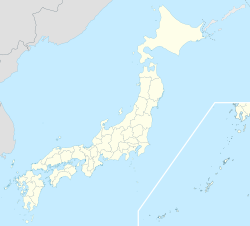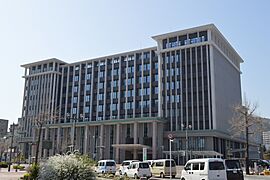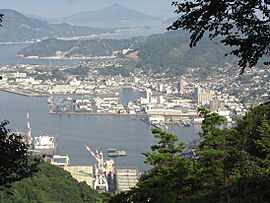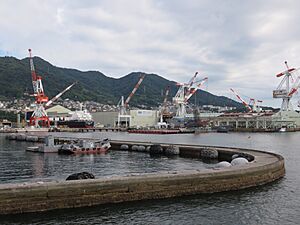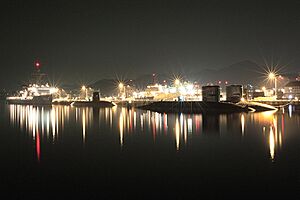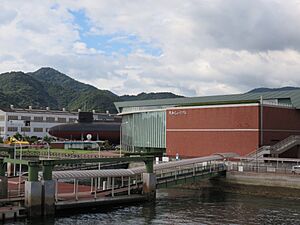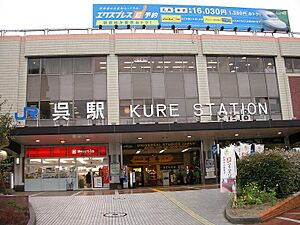Kure, Hiroshima facts for kids
Quick facts for kids
Kure
呉市
|
|||||||||||
|---|---|---|---|---|---|---|---|---|---|---|---|
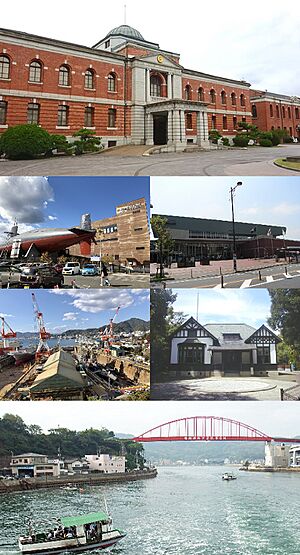
|
|||||||||||
|
|||||||||||
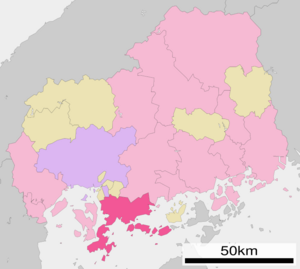 |
|||||||||||
| Country | Japan | ||||||||||
| Region | Chūgoku (Sanyō) | ||||||||||
| Prefecture | Hiroshima | ||||||||||
| Area | |||||||||||
| • Total | 352.80 km2 (136.22 sq mi) | ||||||||||
| Population
(April 30, 2023)
|
|||||||||||
| • Total | 208,024 | ||||||||||
| • Density | 589.637/km2 (1,527.153/sq mi) | ||||||||||
| Time zone | UTC+09:00 (JST) | ||||||||||
| City hall address | 4-1-6 Chūō, Kure-shi, Hiroshima-ken 737-8501 | ||||||||||
| Climate | Cfa | ||||||||||
|
|||||||||||
Kure (呉市, Kure-shi) is a city in Hiroshima Prefecture, Japan. As of April 2023, about 208,024 people live here. Kure is known for its strong history in industry and naval work. It has one of Japan's oldest naval dockyards. Today, it's still an important base for the Japan Maritime Self-Defence Force.
Contents
Kure's Rich History
The area where Kure is located was once part of an old province called Aki Province. The port of Kure was a very important seaport during the Edo period in Japan.
In 1889, the Kure Naval District was created. This led to the building of the Kure Naval Arsenal. Because of this, the city quickly grew with lots of steel production and shipbuilding. Kure officially became a city on October 1, 1902.
From 1889 until the end of World War II, Kure was the main headquarters for the Kure Naval District. The dockyards in Kure made some amazing ships. They launched the first large warship built in Japan, the battlecruiser Tsukuba in 1905. They also launched the biggest battleship ever built, the Yamato, in 1940.
Kure During World War II
During World War II, Kure was the Imperial Japanese Navy's largest naval base and arsenal. Most of the city's factories and workers helped the naval base. They made weapons and supported the navy. Towards the end of the war, Kure was heavily bombed by planes in June and July 1945.
After the war, from 1946 to 1952, military groups from the British Commonwealth Occupation Force used Kure as their main base.
Kure Today
Since 2005, Kure has become a popular place for tourists. The Yamato Museum has a huge 1:10 scale model of the Yamato battleship. There's also a museum about Japanese naval history right by the water.
Kure is still a major center for sea-related activities. It has the shipyards of Japan Marine United and many facilities for the Japan Maritime Self-Defence Force. These include training centers and a large hospital. Kure is also home to destroyer and submarine fleets, and a training squadron for the navy.
Important Dates in Kure's History
- July 1, 1889 — The Kure Naval District was set up.
- 1895 — The Kure naval shipyard was built.
- October 1, 1902 — Kure officially became a city.
- November 10, 1903 — The Kure Naval Arsenal was created.
- December 27, 1903 — The Kure rail line opened, connecting Kure to Hiroshima.
- April 1, 1928 — More towns joined Kure.
- April 21, 1941 — Even more towns and villages became part of Kure.
- March 19, 1945 — US Navy planes attacked Japanese warships in Kure.
- May 5, 1945 — The Hiro Naval Arsenal was bombed.
- June 22, 1945 — The Kure Naval Arsenal was bombed.
- July 1, 1945 — Kure had an air raid.
- July 24–28, 1945 — American bombers attacked the remaining fleet in Kure Naval Base.
- July 1, 1954 — The Japan Maritime Self Defense Forces were started.
- October 1, 1956 — More towns and villages merged into Kure.
- November 1, 2000 — Kure became a Special City.
- April 1, 2003 — The town of Shimokamagari joined Kure.
- April 1, 2004 — The town of Kawajiri joined Kure.
- March 20, 2005 — Several towns like Ondo and Kurahashi merged into Kure.
- April 1, 2016 — Kure officially became a Core city, getting more local control.
Kure's Geography
Kure is about 20 kilometers (12 miles) southeast of Hiroshima city. It faces the Seto Inland Sea. The city has steep hills to the north. Mount Yasumi, which is 497 meters (1,631 feet) tall, divides the two main business and industrial areas.
Kure is also next to the Setonaikai National Park. The city includes busy urban areas and factories. It also has some islands with fewer people, like Kurahashi-jima and Toyoshima.
Kure's Climate
Kure has a humid subtropical climate. This means it has hot summers and cool winters. It rains a lot throughout the year, especially in summer.
| Climate data for Kure (1991−2020 normals, extremes 1894−present) | |||||||||||||
|---|---|---|---|---|---|---|---|---|---|---|---|---|---|
| Month | Jan | Feb | Mar | Apr | May | Jun | Jul | Aug | Sep | Oct | Nov | Dec | Year |
| Record high °C (°F) | 19.0 (66.2) |
21.5 (70.7) |
23.8 (74.8) |
28.1 (82.6) |
30.7 (87.3) |
33.7 (92.7) |
36.9 (98.4) |
37.8 (100.0) |
36.1 (97.0) |
31.1 (88.0) |
26.3 (79.3) |
22.7 (72.9) |
37.8 (100.0) |
| Mean daily maximum °C (°F) | 9.5 (49.1) |
10.2 (50.4) |
13.6 (56.5) |
18.7 (65.7) |
23.3 (73.9) |
26.1 (79.0) |
29.9 (85.8) |
31.5 (88.7) |
28.1 (82.6) |
22.9 (73.2) |
17.3 (63.1) |
11.9 (53.4) |
20.3 (68.5) |
| Daily mean °C (°F) | 6.1 (43.0) |
6.5 (43.7) |
9.6 (49.3) |
14.4 (57.9) |
19.0 (66.2) |
22.4 (72.3) |
26.5 (79.7) |
27.9 (82.2) |
24.5 (76.1) |
19.2 (66.6) |
13.6 (56.5) |
8.4 (47.1) |
16.5 (61.7) |
| Mean daily minimum °C (°F) | 2.8 (37.0) |
3.0 (37.4) |
5.7 (42.3) |
10.4 (50.7) |
15.2 (59.4) |
19.4 (66.9) |
23.8 (74.8) |
25.0 (77.0) |
21.5 (70.7) |
15.8 (60.4) |
10.0 (50.0) |
5.0 (41.0) |
13.1 (55.6) |
| Record low °C (°F) | −5.4 (22.3) |
−7.1 (19.2) |
−4.9 (23.2) |
−0.5 (31.1) |
4.7 (40.5) |
10.1 (50.2) |
14.8 (58.6) |
16.4 (61.5) |
9.7 (49.5) |
4.4 (39.9) |
0.0 (32.0) |
−5.5 (22.1) |
−7.1 (19.2) |
| Average precipitation mm (inches) | 41.5 (1.63) |
59.3 (2.33) |
106.7 (4.20) |
126.0 (4.96) |
147.2 (5.80) |
217.9 (8.58) |
251.4 (9.90) |
113.2 (4.46) |
143.7 (5.66) |
97.2 (3.83) |
65.1 (2.56) |
48.3 (1.90) |
1,417.2 (55.80) |
| Average snowfall cm (inches) | 1 (0.4) |
2 (0.8) |
trace | 0 (0) |
0 (0) |
0 (0) |
0 (0) |
0 (0) |
0 (0) |
0 (0) |
0 (0) |
0 (0) |
3 (1.2) |
| Average precipitation days (≥ 1.0 mm) | 4.7 | 6.5 | 8.8 | 9.0 | 8.6 | 10.6 | 9.6 | 6.5 | 8.1 | 6.4 | 5.8 | 5.3 | 89.9 |
| Average snowy days (≥ 1 cm) | 0.3 | 0.7 | 0.1 | 0 | 0 | 0 | 0 | 0 | 0 | 0 | 0 | 0 | 1.1 |
| Average relative humidity (%) | 63 | 63 | 63 | 63 | 67 | 75 | 76 | 73 | 70 | 66 | 66 | 65 | 68 |
| Mean monthly sunshine hours | 140.7 | 145.7 | 181.7 | 194.8 | 212.3 | 155.9 | 183.9 | 217.9 | 166.8 | 176.0 | 150.5 | 141.6 | 2,067.9 |
| Source: Japan Meteorological Agency | |||||||||||||
Kure's Population and Economy
Kure's population has been slowly decreasing over the last 40 years.
| Historical population | ||
|---|---|---|
| Year | Pop. | ±% |
| 1940 | 355,297 | — |
| 1950 | 292,769 | −17.6% |
| 1960 | 291,887 | −0.3% |
| 1970 | 306,222 | +4.9% |
| 1980 | 302,766 | −1.1% |
| 1990 | 280,429 | −7.4% |
| 2000 | 259,224 | −7.6% |
| 2010 | 239,553 | −7.6% |
| Kure population statistics | ||
Major Companies in Kure
Several important companies have operations in Kure:
- Disco Corporation has three factories.
- Japan Marine United has a shipyard.
- Mitsubishi Hitachi Power Systems
- Mitutoyo
- Nisshin Steel
- Oji Paper Company
- Sailor Pen Company
- Yodogawa Steel Works
Education in Kure
Kure has many schools for different age groups.
Colleges and Universities
- Goko Academy
- Japan Coast Guard Academy
- Kure Kyosai Hospital Nursing College
- Kure University
- National Institute of Technology, Kure College
Schools for Kids
The city government runs 37 public elementary schools and 25 public junior high schools. There is also one public high school run by the city. The Hiroshima Prefecture also operates seven public high schools and two special education schools for students with disabilities. Kure also has one private middle school and three private high schools.
Getting Around Kure
Train Lines
- Yasuura - Ato - Akikawajiri - Nigata - Hiro - Shin-Hiro - Akiaga - Kure - Kawaraishi - Yoshiura - Karugahama - Tennō - Kure-Portopia
Main Roads
 Higashihiroshima-Kure Expressway
Higashihiroshima-Kure Expressway Hiroshima-Kure Road
Hiroshima-Kure Road- National Route 31
- National Route 185
- National Route 375
- National Route 487
Kure's International Connections
Kure has special agreements with other cities around the world. These are called sister cities or friendship cities/ports.
Sister Cities
 Bremerton, Washington, United States (since August 1970)
Bremerton, Washington, United States (since August 1970) Marbella, Andalusia, Spain (since December 1990)
Marbella, Andalusia, Spain (since December 1990) Jinhae-gu, Changwon, South Gyeongsang, South Korea (since October 1999)
Jinhae-gu, Changwon, South Gyeongsang, South Korea (since October 1999) Keelung, Taiwan (since April 2017)
Keelung, Taiwan (since April 2017)
Friendship Cities

 Daisen, Tottori (since September 1995)
Daisen, Tottori (since September 1995)
Friendship Ports
Fun Places to Visit in Kure
Kure has many interesting places to explore!
Museums to Explore
- Irifuneyama Memorial Museum
- JMSDF Kure Museum (You can see a real submarine here, nicknamed Iron Whale Museum!)
- Kurahashi-cho Nagato Museum of Shipbuilding History
- Kure Municipal Museum of Art and Museum Avenue
- Rantokaku Art Museum
- Sannose Gohonjin Art and Culture
- Yamato Museum (See a giant model of the battleship Yamato!)
Shrines and History
- Kameyama Shrine
- Former Kure-chinjufu (An old naval headquarters)
- Former House of Prince Takamatsu
- House of Kimiyo Fujii
- Takechimaru anti-invasion cement ships (Unique historical ships)
Parks and Gardens
- Allay Karasu Kojima Park
- Kure Port-pia Park
- Nagasako Park
- Nikokyo Park
- Ondono-seto and Park
- Setonaikai National Park
- Rekishi-no-mieru-Oka and Park
Mountains and Beaches
- Haiga-mine (A mountain)
- Honjo Suigenchi
- Mount Noro
- Mount Yasumi
- Nikyu-kyo
- Kajigahama Beach
- Romantic Beach Karuga
Festivals in Kure
Kure celebrates with exciting festivals throughout the year.
- Kure Port Festival
- Kure Fireworks above the Sea (usually in late July or early August)
- Kameyama Shrine Festival (on the second Sunday in October and the day before)
Famous People from Kure
Many talented people come from Kure.
Musicians
- Michiru Jo
- Machico
- Miyu Matsuki
- Akira Sakata
- Hitomi Shimatani
Authors
- Hiromu Ono
- Shinji Wada
Sports Stars
- Fumio Fujimura
- Shinji Hamazaki
- Ryō Hirakawa
- Tatsuro Hirooka
Politicians
- Rob Lucas
See also
 In Spanish: Kure para niños
In Spanish: Kure para niños




